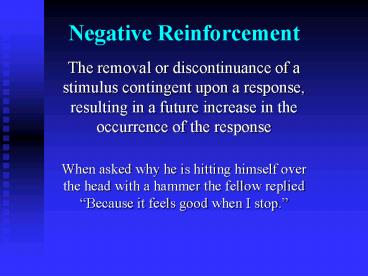Negative Reinforcement - PowerPoint PPT Presentation
1 / 8
Title:
Negative Reinforcement
Description:
Negative Reinforcement ... experiencing signaled aversive stimuli can be relaxed, ... The person does not know when the aversive stimulus is no longer available ... – PowerPoint PPT presentation
Number of Views:341
Avg rating:3.0/5.0
Title: Negative Reinforcement
1
Negative Reinforcement
- The removal or discontinuance of a stimulus
contingent upon a response, resulting in a future
increase in the occurrence of the response - When asked why he is hitting himself over the
head with a hammer the fellow replied Because it
feels good when I stop.
2
Types of Negative Reinforcement
- I. Escape
- Escape involves a response that terminates an
ongoing aversive stimulation - The aversive stimulus or situation is already
being experienced - II. Avoidance
- Avoidance involves performing a response that
postpones the onset of aversive stimulation
3
Developing Avoidance Behavior
- As the aversive stimulus is experienced, cues are
noticed by the organism which signal the onset of
the aversive stimulus and which become
conditioned aversive stimuli - Organisms experiencing signaled aversive stimuli
can be relaxed, performing the avoidance response
as necessary, never experiencing the aversive
stimulus - If the aversive stimulus is unsignaled, the
organism will not know when to perform the
avoidance response
4
A Model of Neurotic Behavior
- The compulsive and repetitive nature of
unsignaled avoidance behavior provides a model
for what has been called neurosis - The person caught in an unsignaled avoidance
situation will continuously perform the avoidance
response and will be very anxious when not
performing it - The person is fearful if not performing the
behavior - Its the not knowing that produces the
fear - The person might also become passive and
unresponsive (learned helplessness)
5
Extinction of Avoidance Behavior
- Avoidance behavior is difficult to extinguish
- The person does not know when the aversive
stimulus is no longer available - Extinguishing avoidance responses The person
must refrain from performing the avoidance
response when the signal is experienced
6
Extinguishing Avoidance Behaviors
- In order to extinguish an avoidance response, the
person must come in contact with the avoided
situation without experiencing the aversive
stimulus - This can be done gradually or all at once
- Doing it gradually involves a procedure known as
desensitization - Doing it all at once is known as flooding
7
Systematic Desensitization
- This procedure functions by gradually exposing
the person to a feared stimulus or situation and
replacing the fear response with an incompatible
response - It involves three stages
- 1. Relaxation training (the incompatible
response) - 2. Development of a fear hierarchy
- 3. Exposing the person through mental images
to the scenes of the fear hierarchy while the
person is relaxed
8
Desensitization with a child
- When using desensitization with a child, teaching
relaxation techniques is often not an option so
an alternative distractor can be used

